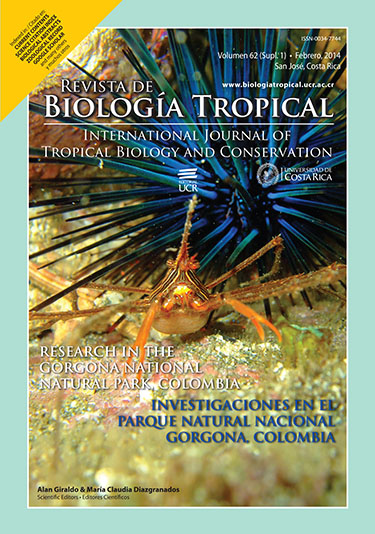Abstract
Male Tettigoniidae emit sound to attract conspecific females. The sound is produced by stridulation. During stridulation the forewings open and close, but it is during the closing stroke that the scraper contacts the file teeth to generate the predominant sound components, which are amplified by adjacent wing cells specialized in sound radiation. The sounds usually exceed the sonic boundary and might occur above 40 kHz, reaching extreme ultrasonic frequencies of 150kHz in some species. Here we test the hypothesis that Tettigoniidae species should prefer microhabitats that favour efficient signal transmission, i.e. that there is a relationship of sound frequency with the vertical distribution of the species (from ground to canopy) at Gorgona National Natural Park, Colombia. We sampled 16 trees and four different altitudinal levels between 1 and 20m above the understory vegetation. We placed collecting blankets separated by vertical distances of 5m, and knocked insects down using the technique known as fogging. We found no correlation between vertical distribution and carrier frequency, but there was a preference for open spaces (below the canopy and above the understory) in species using extreme ultrasound. This is the first quantitative description of the vertical distribution in neotropical species of the family Tettigoniidae and its relationship to the calling song frequency. Rev. Biol. Trop. 62 (Suppl. 1): 289-296. Epub 2014 February 01.
References
Bailey, W. J. (1970(. The mechanics of stridulation in bush crickets (Tettigonioidea, Orthoptera) I. Tegminal generator. Journal of Experimental Biology, 52: 495-505.
Bass, H. E., Sutherland, L. C. & Zuckerwar, A. J. (1990). Atmospheric absorption of sound-update. Journal of the Acoustical Society of America, 88: 2019-2021.
Bennet-Clark, H. C. (1999). Resonators in insect sound production: How insects produce loud pure-tone songs. Journal of Experimental Biology, 202: 3347-3357.
Bennet-Clark, H. C. (2003). Wing resonances in the Australian field cricket Teleogryllus oceanicus. Journal of Experimental Biology, 206: 1479-1496.
Bennet-Clark, H. C. & Bailey, W. J. (2002). Ticking of the clockwork cricket: The role of the escapement mechanism. Journal of Experimental Biology, 205: 613-625.
Diwakar, S. & Balakrishnan, R. (2007). Vertical stratification in an acoustically communicating ensiferan assemblage of a tropical evergreen forest in southern India. Journal of Tropical Ecology, 23: 479-486.
Chamorro, C. (1990). Suelos. In J. Aguirre & J. O. Rangel (Eds.), Biota y ecosistemas de Gorgona (pp. 65-72). Fondo FEN, Bogotá, Colombia.
Erwin, T. L. (1989). Canopy arthropod biodiversity: A chronology of sampling techniques and results. Revista Peruana de Entomología, 32: 71-77.
Heller, K. G. (1988). Bioakustik der europäischen Laubheuschrecken. Margraf, Weikersheim.
Koch, U. T., Elliott, C. J. H., Schaffner, K. H. & Kleindienst, H. U. (1988). The mechanics of stridulation of the cricket Gryllus campestris. Journal of Comparative Physiology, 162: 213-223.
Marten, K., Quine, D. & Marler, P. (1977). Sound transmission and its significance for animal vocalization. Ii. Tropical forest habitats. Behavioral Ecology and Sociobiology, 2: 291-302.
Mason, A. C. & Bailey, W. J. (1998). Ultrasound hearing and male-male communication in Australian katydids (Tettigoniidae : Zaprochilinae) with sexually dimorphic ears. Physiological Entomology, 23: 139-149.
Mercado, E. & Frazer, L. N. (1999). Environmental constraints on sound transmission by humpback whales. Journal of the Acoustical Society of America, 106: 3004-3016.
Montealegre-Z, F. (2009). Scale effects and constraints for sound production in katydids (Orthoptera: Tettigoniidae): Generator morphology constrains signal parameters. Journal of Evolutionary Biology, 22: 355-366.
Montealegre-Z, F., Guerra, P. A. & Morris, G. K. (2003). Panoploscelis specularis (Orthoptera: Tettigoniidae: Pseudophyllinae): Extraordinary female sound generator, male description, male protest and calling signals. Journal of Orthoptera Research, 12: 173-181.
Montealegre-Z, F. & Mason, A. C. (2005). The mechanics of sound production in Panacanthus pallicornis (Orthoptera : Tettigoniidae : Conocephalinae): The stridulatory motor patterns. Journal of Experimental Biology, 208: 1219-1237.
Montealegre-Z, F. & Morris, G. K. (1999). Songs and systematics of some Tettigoniidae from Colombia and Ecuador, part I. Pseudophyllinae (Orthoptera). Journal of Orthoptera Research, 8: 163-236.
Montealegre-Z, F. & Morris, G. K. (2003). Uchuca giglio-tos, Dectinomima caudell and their allies (Orthoptera: Tettigoniidae: Conocephalinae). Transactions of the American Entomological Society, 129: 503-537.
Montealegre-Z, F., Morris, G. K. & Mason, A. C. (2006). Generation of extreme ultrasonics in rainforest katydids. Journal of Experimental Biology, 209: 4923-4937.
Morris, G. K. (1999). Song in arthropods. In K. G. Davey (Ed.), Encyclopedia of reproduction, (Vol. 4, pp. 508-517). Academic Press, San Diego.
Morris, G. K., Mason, A. C., Wall, P. & Belwood, J. J. (1994). High ultrasonic and tremulation signals in neotropical katydids (Orthoptera, Tettigoniidae). Journal of Zoology, 233: 129-163.
Nickle, D. A. & Castner, J. L. (1995). Strategies utilized by katydids (Orthoptera: Tettigoniidae) against diurnal predators in rainforests of northeastern Peru. Journal of Orthoptera Research, 4: 75-88.
Pierce, G. W. (1948). The songs of insects: With related material on the production, propagation, detection, and measurement of sonic and supersonic vibrations. Harvard University Press, Massachusetts, USA.
Pimienta, M. C. (2005). Protocolo para la caracterización de insectos de dosel. Segundo informe, contrato de prestación de servicios No. 173/04. Instituto Alexander von Humboldt, Bogotá, Colombia.
Rangel, O. & Rudas, A. (1990). Aspectos microclimáticos. In J. Aguirre & J. O. Rangel (Eds.), Biota y ecosistemas de Gorgona (pp. 41-51). Fondo FEN, Bogotá, Colombia.
Robinson, D. J. & Hall, M. J. (2002). Sound signalling in Orthoptera. Advances in Insect Physiology, 29: 151-278.
Römer, H. (1993). Environmental and biological constraints for the evolution of long-range signalling and hearing in acoustic insects. Philosophical Transactions of the Royal Society Biological Sciences, 340: 179-185.
Römer, H. & Lewald, J. (1992). High-frequency sound transmission in natural habitats: Implications for the evolution of insect acoustic communication. Behavioral Ecology and Sociobiology, 29: 437-444.
Römer, H., Spickermann, M. & Bailey, W. (1998). Sensory basis for sound intensity discrimination in the bushcricket Requena verticalis (Tettigoniidae, Orthoptera). Journal of Comparative Physiology, 182: 595-607.
Suga, N. (1966). Ultrasonic production and its reception in some neotropical Tettigoniidae. Journal of Insect Physiology, 12: 1039-1050.
##plugins.facebook.comentarios##

This work is licensed under a Creative Commons Attribution 4.0 International License.
Copyright (c) 2014 Revista de Biología Tropical






